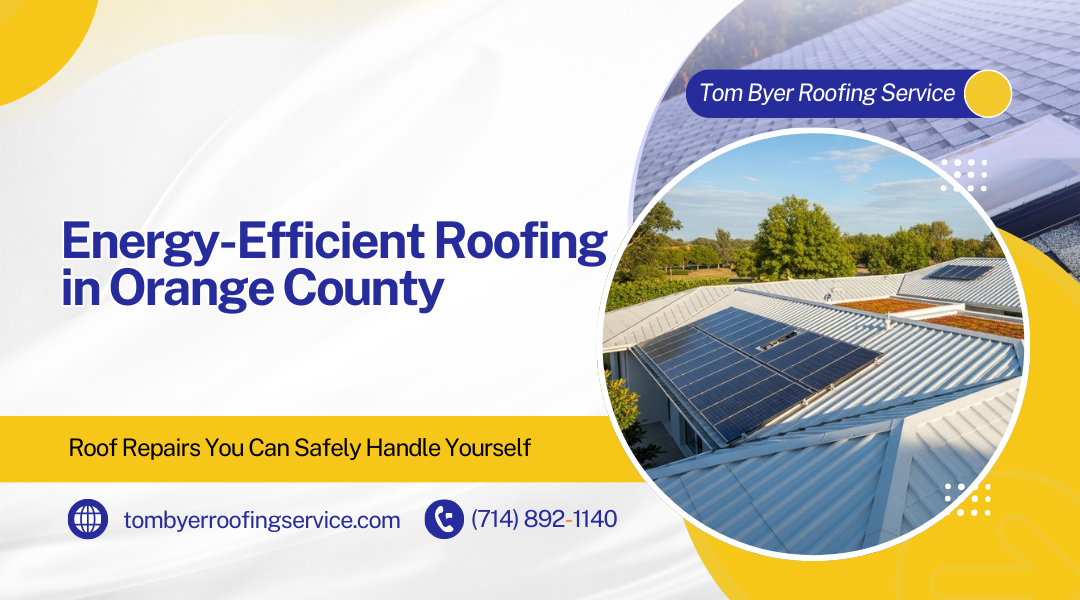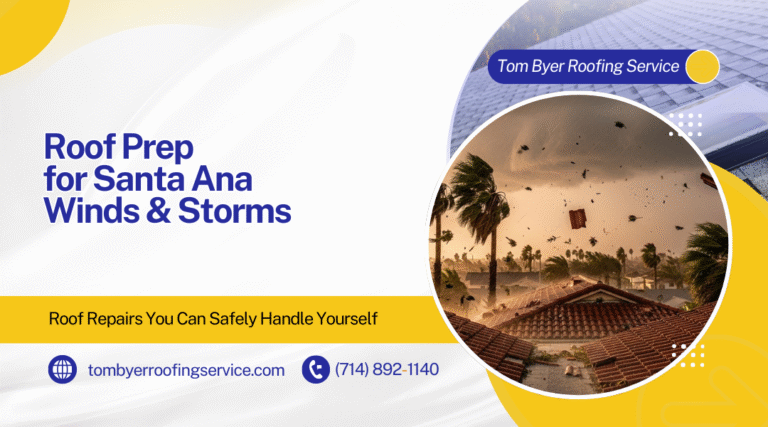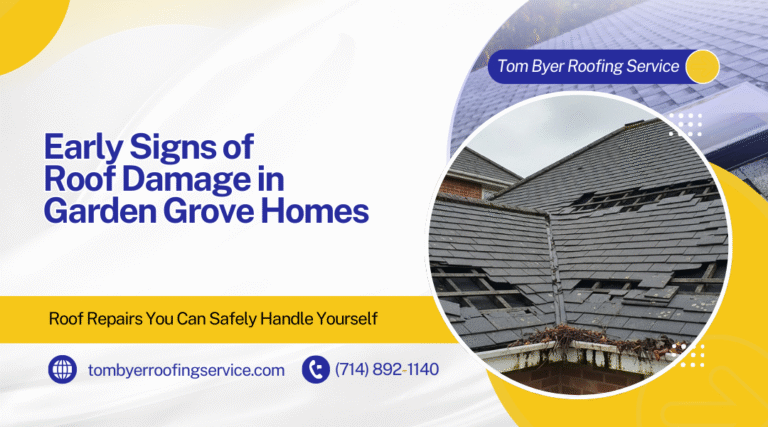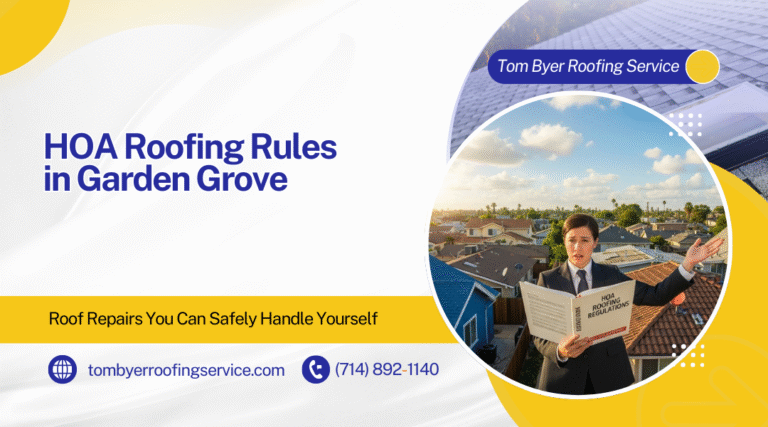Keeping your business cool in Orange County’s heat can feel like a constant battle with rising energy bills. The roof over your property plays a bigger role than you might think in controlling indoor temperatures and cutting operating costs. By choosing an energy-efficient roofing system, you can reduce cooling expenses, extend the life of your roof, and create a more comfortable environment for employees and customers.
You face unique challenges in this region’s climate, where long summers and direct sunlight put constant stress on commercial roofs. Traditional materials often absorb heat, forcing air conditioning systems to work harder. Energy-efficient roofing options, such as reflective coatings and advanced materials, help minimize this strain while supporting California’s broader energy goals.
At Tom Byer Roofing Service in Garden Grove, you gain access to proven solutions designed for local businesses. With decades of experience and a focus on durability, our team provides roofing systems that protect your property, improve efficiency, and deliver measurable savings over time.
Why Energy Efficiency Matters for Commercial Roofing in Orange County
Energy-efficient roofing directly affects your operating costs and the comfort of your building. It also plays a critical role in how your roof performs under Orange County’s coastal climate, where heat, sunlight, and humidity all influence long-term durability and utility expenses.
Rising Energy Costs and Business Overheads
In California, electricity rates are among the highest in the country. For businesses, this means cooling costs can take up a large share of monthly expenses. An inefficient roof forces your HVAC system to run longer, which increases both energy bills and equipment wear.
By upgrading to reflective or insulated roofing materials, you can reduce heat transfer into your building. This lowers demand on air conditioning and creates a more stable indoor temperature. Even small improvements in insulation or reflectivity can cut energy use by noticeable margins.
Many commercial properties also qualify for state and federal incentives. These include rebates based on the roofing material’s Solar Reflectance Index (SRI) and compliance with California’s Title 24 energy code. Taking advantage of these programs helps offset upfront costs and improves long-term savings.
Impact of Orange County’s Climate on Roof Performance
Orange County experiences long summers, high UV exposure, and occasional coastal humidity. These conditions can shorten the lifespan of traditional roofing materials and raise cooling demands. Roofs that absorb heat or degrade quickly under sunlight become costly to maintain and operate.
Energy-efficient solutions such as cool roofs, metal roofing, or green roof systems are designed to handle this climate. They reflect more sunlight, resist UV damage, and help regulate indoor temperatures. This reduces strain on your HVAC system and helps prevent premature roof deterioration.
Coastal areas like Garden Grove and Huntington Beach also face heat island effects, where built-up surfaces trap heat. Using light-colored or reflective roofing materials can reduce this impact, keeping your property cooler while supporting compliance with local energy codes.
Key Features of Energy-Efficient Roofing Systems
Energy-efficient roofing reduces heat gain, improves interior comfort, and lowers the demand on cooling equipment. The main factors include reflective surfaces, effective insulation layers, and proper ventilation design.
Cool Roof Coatings and Reflective Materials
Cool roof systems use light-colored coatings or reflective membranes that bounce sunlight away from the surface. By lowering heat absorption, the roof stays cooler during peak sun hours. This reduces the temperature inside your building and decreases the load on air conditioning units.

Common materials include white elastomeric coatings, reflective single-ply membranes, and metal roofing with specialized finishes. These products can raise a roof’s solar reflectance index (SRI), which measures how well a surface reflects sunlight and releases heat.
For Orange County’s sunny climate, reflective roofing is especially effective. Lower roof surface temperatures can extend the life of roofing materials by reducing thermal stress. You also benefit from more stable indoor temperatures, which helps maintain comfort for employees and customers.
Insulation and Thermal Barriers
Insulation plays a direct role in controlling how much heat enters or leaves your building. A properly insulated roof slows heat transfer, keeping indoor spaces cooler in summer and warmer in winter. This reduces the strain on HVAC systems and lowers energy costs.
Commercial roofs often use rigid foam boards, spray polyurethane foam, or layered insulation systems. The type and thickness depend on your building’s structure and energy needs. Adding a thermal barrier can also improve fire resistance while meeting local building codes.
In Orange County, where cooling demand is higher than heating, insulation helps maintain consistent indoor temperatures during long hot seasons. This not only saves energy but also improves comfort for staff and visitors.
Ventilation Systems for Commercial Buildings
Ventilation works with insulation and reflective surfaces to manage heat buildup. A well-designed system allows hot air to escape and cooler air to circulate. This prevents trapped heat from raising interior temperatures and reduces moisture that can damage roofing materials.
Options for commercial roofs include ridge vents, turbine vents, and mechanical exhaust fans. Each system supports airflow in different ways, depending on the building’s size and roof design.
Proper ventilation also extends the lifespan of your roof by reducing condensation and preventing mold growth. For businesses in Orange County, this means fewer maintenance issues and a healthier indoor environment.
Types of Energy-Efficient Roofing Options for Businesses
Energy-efficient roofing can lower your cooling costs, extend the life of your roof, and support long-term sustainability goals. The right material can improve indoor comfort, reduce strain on HVAC systems, and even create opportunities for renewable energy use.
TPO and PVC Roofing Membranes
TPO (thermoplastic polyolefin) and PVC (polyvinyl chloride) membranes are popular for flat or low-slope commercial roofs. Both materials are highly reflective, which helps reduce heat absorption and lowers cooling costs during Orange County’s warm summers.
These membranes are lightweight yet durable. They resist UV rays, chemical exposure, and punctures, making them a reliable choice for high-traffic or industrial rooftops. Installation is typically done in large sheets, minimizing seams and reducing the chance of leaks.
Key advantages:
- Reflective surface cuts energy use
- Long service life with proper maintenance
- Compatible with many commercial building designs
If you want a cost-effective system that balances performance and durability, TPO and PVC are strong options.
Metal Roofing with Reflective Finishes
Metal roofing is another efficient solution for commercial properties. When coated with reflective finishes, metal panels deflect solar heat instead of absorbing it. This reduces the demand on your air conditioning system and helps stabilize indoor temperatures.
Metal roofs are known for their long lifespan, often lasting 40–70 years with minimal upkeep. They are also fire-resistant and recyclable, which makes them a sustainable choice.
You can choose from different panel styles and colors, many of which meet ENERGY STAR® standards for reflectivity. Adding insulation beneath the panels can further improve performance.
Benefits include:
- Extended roof life compared to asphalt
- Low maintenance requirements
- Strong resistance to weather and fire
For businesses looking for durability and energy savings, reflective metal roofing is a practical investment.
Green and Solar-Ready Roof Systems
Green roofs use vegetation to provide natural insulation. They reduce heat transfer, improve air quality, and can extend the life of the roofing system by protecting it from direct sunlight. While they require professional installation and ongoing care, they offer strong environmental and energy benefits.

Solar-ready roofs integrate design features that support the addition of solar panels. This includes proper load capacity, layout planning, and reflective or cool surfaces that work well with photovoltaic systems. Installing a solar-ready roof makes it easier to add renewable energy in the future without major modifications.
Options to consider:
- Vegetative layers for insulation and stormwater control
- Flat or low-slope roofs designed for solar panel placement
- Roofing materials with coatings that complement solar efficiency
If you want to combine energy savings with renewable power generation, green and solar-ready systems give you flexibility and long-term value.
Cost Savings and ROI for Business Owners
Energy-efficient roofing helps you cut operating expenses while improving the long-term value of your property. It can lower daily utility use, reduce upkeep needs, and provide access to financial incentives that ease the cost of upgrades.
Reduced Air Conditioning and Cooling Bills
In Orange County, hot summers drive up cooling costs for many businesses. Standard roofing materials often absorb and trap heat, forcing your air conditioning system to work harder. Energy-efficient roofing reflects more sunlight and releases stored heat faster, which keeps indoor temperatures more stable.
By reducing heat gain, you use less electricity to maintain comfortable conditions. This not only lowers monthly energy bills but also decreases strain on your HVAC system. Less strain means fewer repairs and a longer service life for your cooling equipment.
For many businesses, this translates into measurable savings each month. Over time, the reduction in energy use can offset a large portion of the roofing investment.
Example of potential savings:
| Roof Type | Cooling Cost Impact | Estimated Savings* |
|---|---|---|
| Traditional dark roof | High | — |
| Reflective energy roof | Lower | 10–30% annually |
*Savings vary by building size and system efficiency.
Extended Roof Lifespan and Lower Maintenance Costs
Energy-efficient roofing materials are built to handle heat, UV rays, and weather conditions more effectively than traditional options. By resisting thermal stress and reducing surface temperature swings, the roof structure experiences less wear and tear.
This durability often extends the lifespan of the system, which delays costly replacements. A longer-lasting roof means you can spread the initial investment over more years, improving your return on investment.
Maintenance costs also tend to drop. Reflective and insulated roofing systems are less prone to cracking, warping, or premature material breakdown. Fewer issues reduce the need for frequent patching, inspections, and emergency service calls.
Over time, the combination of fewer repairs and extended service life creates significant financial value for your business.
Potential Rebates, Incentives, and Tax Benefits
Upgrading to an energy-efficient roofing system may qualify you for financial incentives at the local, state, or federal level. Programs often reward property owners who reduce energy consumption or install materials that meet specific efficiency standards.
In California, you may find rebates through utility companies or state energy programs. These can lower upfront costs and make the project more affordable. Some business owners also benefit from federal tax deductions for energy-efficient improvements.
You should also consider accelerated depreciation options under the IRS Section 179D deduction, which can apply to qualifying commercial building upgrades. These tax advantages reduce the overall payback period of your investment.
By combining rebates, incentives, and tax savings, you can cut thousands of dollars from project costs while still gaining the long-term energy and maintenance benefits.
Common Mistakes Businesses Make with Roofing Efficiency
Energy-efficient roofing can cut cooling costs and extend the life of your building. Yet many businesses lose money and comfort because of poor material choices, skipped upkeep, or failure to meet local energy standards.
Choosing Low-Cost Materials That Trap Heat
It may be tempting to pick the cheapest roofing option, but low-cost materials often absorb heat instead of reflecting it. Dark asphalt or poorly coated surfaces raise indoor temperatures, forcing your HVAC system to work harder.
In Orange County’s warm climate, this mistake can lead to higher utility bills during long summers. Reflective membranes, cool roof coatings, or light-colored materials perform better by reducing heat gain.
When you only consider upfront price, you risk paying more over time. A roof that lacks reflective or insulating qualities can increase cooling costs by 15–20%. Investing in higher-quality materials helps you manage long-term operating expenses and reduces strain on your equipment.
A quick comparison:
| Material | Heat Absorption | Energy Efficiency | Typical Cost Impact |
|---|---|---|---|
| Dark Asphalt | High | Low | Higher bills |
| White TPO/PVC | Low | High | Lower bills |
Ignoring Maintenance of Reflective or Insulated Systems
Even the best roofing system loses efficiency without proper upkeep. Dust, debris, or standing water on reflective surfaces reduce their ability to bounce back sunlight. Small cracks in insulation or seams can also allow heat transfer.
You should schedule regular inspections and cleaning at least twice a year. This helps maintain reflectivity and ensures insulation stays intact. Neglecting maintenance can shorten the life of your roof and increase cooling costs.
For example, a reflective roof with dirt buildup may reflect 20% less sunlight than a clean one. That drop directly affects indoor temperatures and energy use.
Simple steps like clearing drains, removing debris, and sealing small gaps protect your investment and keep energy savings consistent.
Overlooking Local Energy Codes and Regulations
Orange County follows California’s Title 24 energy standards, which require certain roofing materials and insulation levels for commercial buildings. Ignoring these rules can lead to fines, failed inspections, or costly retrofits.
You also miss out on potential rebates and incentives tied to compliance. Many utility programs reward businesses that install qualifying cool roofs or meet insulation requirements.
By not checking local codes before installation, you risk choosing materials that don’t meet reflectivity or thermal performance standards. This can delay projects and increase costs.
Work with a licensed contractor who understands Orange County’s building codes and climate needs. Doing so ensures your roofing system meets legal requirements while maximizing energy efficiency.
Why Work with Tom Byer Roofing Service for Energy-Efficient Solutions
Choosing the right contractor affects how well your roof performs, how much you save on energy, and how smoothly your project moves forward. You benefit most from a team that understands local conditions, follows regulations closely, and tailors solutions to your building’s needs.
Local Expertise in Orange County Commercial Roofing
When you work with a local contractor, you gain the advantage of their knowledge of the region’s climate and building styles. Orange County faces long, hot summers and occasional heavy rains, which put stress on commercial roofing systems.
Tom Byer Roofing Service has decades of experience working with these exact conditions. This means your roof will be designed to handle heat, reflect sunlight, and maintain durability in changing weather.
Their crews also know the most common roof types in commercial areas of Garden Grove, Anaheim, and nearby cities. Whether your property has a flat roof or a sloped design, they recommend materials that have proven performance in local conditions.
This experience reduces the risk of costly mistakes and ensures your investment in energy-efficient roofing lasts longer.
Knowledge of Building Codes, HOA, and Energy Standards
Commercial roofing projects in California must follow strict rules. Title 24 energy codes require materials that reduce heat gain, and many properties must also meet HOA guidelines or city-specific regulations.
Tom Byer Roofing Service has worked with these requirements for decades. They understand solar reflectance index (SRI) ratings, insulation standards, and fire safety codes that apply to commercial buildings in Orange County.
If your property is in a managed community or business park, HOA rules may limit roof color, material, or design. Their team helps you choose options that meet these rules without sacrificing efficiency.
By staying current with state and local codes, they help you avoid delays, failed inspections, or penalties.
Customized Plans to Maximize Savings for Each Business
Every business has different energy demands and budget goals. A warehouse may need reflective coatings to reduce cooling costs, while an office building might benefit from advanced insulation or even solar-integrated roofing.
Tom Byer Roofing Service evaluates your current roof, energy usage, and long-term plans before recommending a system. This ensures you invest in upgrades that deliver measurable results instead of unnecessary features.
They also consider available rebates and tax incentives in California. By factoring these into your plan, you can reduce upfront costs while improving long-term savings.
This customized approach means your roof is not just energy-efficient, but also aligned with your financial and operational priorities.




